The Saint of the Day
 |
 |
 |
 |
 |
 |
 |
St. Ampelio – May 14
Biographical selection:
The life of St. Ampelio the blacksmith is mostly legendary. He was said to be a blacksmith in Egypt in the 5th century. Seeking spiritual perfection, he went to serve the monks of Thebaid by the labor of his trade.
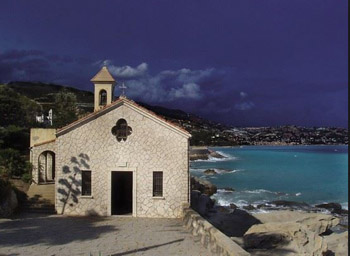 Once, the Devil transformed himself into an impure young woman and went to tempt him. Ampelio took a blazing red-hot iron in his hand and threatened to burn her. The woman disappeared and he was never tempted in this way again.
Once, the Devil transformed himself into an impure young woman and went to tempt him. Ampelio took a blazing red-hot iron in his hand and threatened to burn her. The woman disappeared and he was never tempted in this way again.
Already old, he left Thebaid and went to Italy to the outskirts of Bordighera, south of Genoa, where he led a life of contemplation. St. Ampelio is the Patron Saint of the blacksmiths.
Comments of Prof. Plinio:
To say that the life of St. Ampelio in mostly legendary does not seem very objective, because if he was canonized by the Church, we are certain that he existed and was a saint. At times, however, those early canonizations were not made regularly. They were an inspiration of the Holy Spirit who roused a whole people to proclaim a person a saint in a single voice.
And the person was in fact a saint. The authority of the Church was invoked, but without an entirely regular process, as became the practice later.
As you see, the bibliographical data in this selection are poor, thus fating my comments to be poor as well.
What we can do is to imagine what the life of this Saint would be as an ambulatory blacksmith in Thebaid in the 5th century.
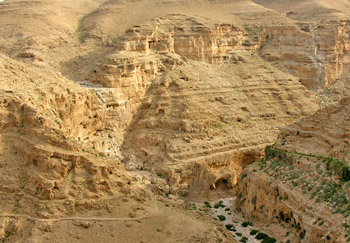 In the 5th century, indeed, the hermitic institution was assuming its full profile. In the previous centuries – principally in the 3rd and 4th – the Roman Empire of the West and the East were severely persecuting Catholics. The lives of these early Christians were extremely difficult.
In the 5th century, indeed, the hermitic institution was assuming its full profile. In the previous centuries – principally in the 3rd and 4th – the Roman Empire of the West and the East were severely persecuting Catholics. The lives of these early Christians were extremely difficult.
Many of them fled to the desert in order to escape imprisonment followed by torture and death. These persons would spend their lives in isolated caves in the tranquility of the desert, praying to God for the persecuted Church until they died, sometimes after reaching 90 years of age or more.
But, on this earth God does not allow the life of anyone to be without great and even heroic trials, above all those persons whom He loves more and destines to render a special service to the Church. With regard to those hermits who fled to the desert, you should not imagine that their only martyrdom was the silence and isolation they embraced.
This was a suffering, indeed, since every man has the instinct of sociability, the tendency to communicate with others. It was a true suffering to pass 40 or 50 years without contact with others, except for some rare visitor who would pass by his hermitage once in a while. Perhaps a person who had heard about that hermit would travel to the desert to ask his prayers; at other times it could be a bandit running from the police, a political criminal seeking asylum, a lunatic or a man possessed by the Devil wandering through the area.
We need to add a curious observation. Often places that are very isolated are not blessed, but infested with devils: Cave-dotted hills, swamps, isolated valleys are places easily infested with devils. Often those hermits removed themselves to places like these, thus enduring great isolation as well as that preternatural presence.
 Further, man is made to suffer and fight, and when he flees and runs to the desert, inside his soul turbulence and conflicts spring up. There are interior trials that are more terrible than exterior persecutions.
Further, man is made to suffer and fight, and when he flees and runs to the desert, inside his soul turbulence and conflicts spring up. There are interior trials that are more terrible than exterior persecutions.
A hermit runs to his hermitage in the desert. At first he feels joy and consolation and the graces of God inundate his soul. Then, those joys evaporate and he loses that first unction that elated him. He starts to feel isolated and sad, and temptations start to vibrate in his soul – at times, diabolical temptations, temptations against the Faith. He starts to doubt the veracity of the Catholic Religion itself. The devils appear and simulate feasts in Rome, Alexandria and other grand cities. The hermit experiences hallucinations.
In the 5th century the number of hermits in the desert grew large, but the cause was no longer fear of persecution, which had ended with Constantine. Rather this flight of men and women to the desert was motivated by the fear of losing their souls in the great cities; by the will to offer the sacrifice of their solitude to God. There were so many hermits that someone once said that the desert was overflowing with hermits. In almost all the epochs of the Church there have been many hermits. Our epoch, which lacks true hermits, is unfortunate.
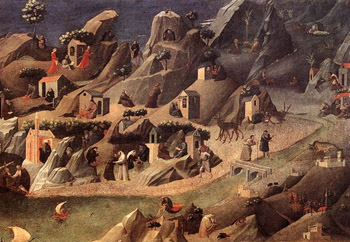 We can picture a man who is a blacksmith by trade going from one hermit to another to offer his service gratis for them. Here is a hermit known for working a miracle, there one who is famous for a particular virtue, over there a woman who is renowned because in the world she is the mother of an emperor. Thus, he goes along his way rendering his services of beating iron, making or repairing metal devices that the hermits need to make their material life easier.
We can picture a man who is a blacksmith by trade going from one hermit to another to offer his service gratis for them. Here is a hermit known for working a miracle, there one who is famous for a particular virtue, over there a woman who is renowned because in the world she is the mother of an emperor. Thus, he goes along his way rendering his services of beating iron, making or repairing metal devices that the hermits need to make their material life easier.
We can picture St. Ampelio as a tourist of the sanctities of the desert. He would have compiled a sort of tourist guide of the marvels of those hermits he served: If you want to know someone with the gift of prophecy go down to that cave where you will find an old man with a long white beard; if you want to know someone who practices heroic penances go to the top of that mountain where you will find a skeletal figure who piously scourges himself; further on is a monk who levitates at noon when he prays the Angelus and greets Our Lady.
So, moved by his admiration for the hermits he served, St. Ampelio transmits to us the desire to know souls.
If this hypothesis is true, we have the virtue we can imitate in this unknown saint. He communicates to us a twofold grace: the desire to have the discernment to know the souls following the path of grace and to admire in each one that which is upright and according to God. To admire in each soul what it would be were it completely faithful, and to admire the degree of fidelity it has that makes it a special reflection of God. Also, it inspires us with the desire for the grace to know what is bad and, by opposition, to love what is good.
I can guarantee you that a person who spends his life studying and knowing souls will have a much more enjoyable life than one who travels to different cities around the world. The true monuments in this world are the souls of men. Nothing is more beautiful, interesting and engaging than to know souls.
With this consideration, we have an invitation for you to be amatores animarum [lovers of souls], a category of people who love souls, who want to know them.
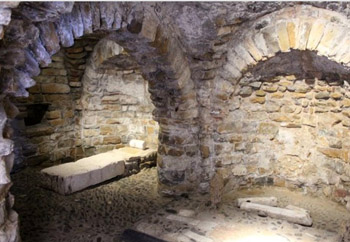 Is there anything in the life of Our Lord that is an example of this? He did this all the time, but the example of the rich young man stands out. The Gospel tells us that Our Lord saw that young man and loved him. He saw in his soul the fidelity he had. On other occasions He dealt with the Pharisees, discerning the very depths of their souls. With infinite wisdom and sanctity He molded all the persons with whom He came into contact.
Is there anything in the life of Our Lord that is an example of this? He did this all the time, but the example of the rich young man stands out. The Gospel tells us that Our Lord saw that young man and loved him. He saw in his soul the fidelity he had. On other occasions He dealt with the Pharisees, discerning the very depths of their souls. With infinite wisdom and sanctity He molded all the persons with whom He came into contact.
We can also imagine His joy when He looked at Our Lady and saw her most perfect soul. We had a great joy recently when the Pilgrim Statue of Our Lady of Fatima visited us. She charmed all of us as well as the multitudes that came into contact with her. Just seeing her statue we were captivated by her. This gives us an idea of what our impression would be if we saw Our Lady personally. It is incalculable!
This and much more was what Our Lord felt when He looked at her. Our Lady also felt something similar when she looked at Him. And when those two gazes would cross, when He would say to her – My Mother! – and she would respond – My Son! – it was the highest, the most noble and the most perfect relationship of souls that existed in History!
So, the invitation that comes to us is to try to know souls, to admire them and to see what they are called to accomplish in order to be faithful.
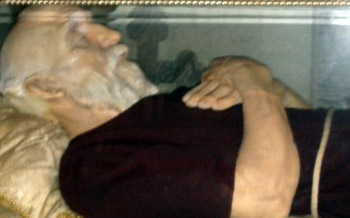 Is there an obstacle in this assignment?
Is there an obstacle in this assignment?
Yes, there is. When we deal with others, instead of thinking about their souls, we think about ourselves. Doing so, we become incapable of knowing others. When we are studying others not to know how they are, but rather to know the effect we are making on them – if they are realizing how refined, prestigious, intelligent, etc. we are – then we cover our eyes with a veil and we cannot know anyone.
It is necessary to love others with disinterest, to know them as reflections of God. Then, we open ourselves to the wonderful world of the souls. Most likely St. Ampelio was a model of admiration.
This is the theme of our meditation today.
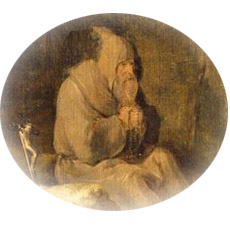


The Saint of the Day features highlights from the lives of saints based on comments made by the late Prof. Plinio Corrêa de Oliveira. Following the example of St. John Bosco who used to make similar talks for the boys of his College, each evening it was Prof. Plinio’s custom to make a short commentary on the lives of the next day’s saint in a meeting for youth in order to encourage them in the practice of virtue and love for the Catholic Church. TIA thought that its readers could profit from these valuable commentaries.
The texts of both the biographical data and the comments come from personal notes taken by Atila S. Guimarães from 1964 to 1995. Given the fact that the source is a personal notebook, it is possible that at times the biographic notes transcribed here will not rigorously follow the original text read by Prof. Plinio. The commentaries have also been adapted and translated for TIA’s site.
The life of St. Ampelio the blacksmith is mostly legendary. He was said to be a blacksmith in Egypt in the 5th century. Seeking spiritual perfection, he went to serve the monks of Thebaid by the labor of his trade.

On Cape Sant'Ampelio is a chapel dedicated to St. Ampelio, patron of blacksmiths
Already old, he left Thebaid and went to Italy to the outskirts of Bordighera, south of Genoa, where he led a life of contemplation. St. Ampelio is the Patron Saint of the blacksmiths.
Comments of Prof. Plinio:
To say that the life of St. Ampelio in mostly legendary does not seem very objective, because if he was canonized by the Church, we are certain that he existed and was a saint. At times, however, those early canonizations were not made regularly. They were an inspiration of the Holy Spirit who roused a whole people to proclaim a person a saint in a single voice.
And the person was in fact a saint. The authority of the Church was invoked, but without an entirely regular process, as became the practice later.
As you see, the bibliographical data in this selection are poor, thus fating my comments to be poor as well.
What we can do is to imagine what the life of this Saint would be as an ambulatory blacksmith in Thebaid in the 5th century.

Caves in the hills of Thebaid in Egypt
Many of them fled to the desert in order to escape imprisonment followed by torture and death. These persons would spend their lives in isolated caves in the tranquility of the desert, praying to God for the persecuted Church until they died, sometimes after reaching 90 years of age or more.
But, on this earth God does not allow the life of anyone to be without great and even heroic trials, above all those persons whom He loves more and destines to render a special service to the Church. With regard to those hermits who fled to the desert, you should not imagine that their only martyrdom was the silence and isolation they embraced.
This was a suffering, indeed, since every man has the instinct of sociability, the tendency to communicate with others. It was a true suffering to pass 40 or 50 years without contact with others, except for some rare visitor who would pass by his hermitage once in a while. Perhaps a person who had heard about that hermit would travel to the desert to ask his prayers; at other times it could be a bandit running from the police, a political criminal seeking asylum, a lunatic or a man possessed by the Devil wandering through the area.
We need to add a curious observation. Often places that are very isolated are not blessed, but infested with devils: Cave-dotted hills, swamps, isolated valleys are places easily infested with devils. Often those hermits removed themselves to places like these, thus enduring great isolation as well as that preternatural presence.

Temptations of St. Anthony of the desert
A hermit runs to his hermitage in the desert. At first he feels joy and consolation and the graces of God inundate his soul. Then, those joys evaporate and he loses that first unction that elated him. He starts to feel isolated and sad, and temptations start to vibrate in his soul – at times, diabolical temptations, temptations against the Faith. He starts to doubt the veracity of the Catholic Religion itself. The devils appear and simulate feasts in Rome, Alexandria and other grand cities. The hermit experiences hallucinations.
In the 5th century the number of hermits in the desert grew large, but the cause was no longer fear of persecution, which had ended with Constantine. Rather this flight of men and women to the desert was motivated by the fear of losing their souls in the great cities; by the will to offer the sacrifice of their solitude to God. There were so many hermits that someone once said that the desert was overflowing with hermits. In almost all the epochs of the Church there have been many hermits. Our epoch, which lacks true hermits, is unfortunate.

In the 5th century the Thebald was so populated that it became known as "desert city"
We can picture St. Ampelio as a tourist of the sanctities of the desert. He would have compiled a sort of tourist guide of the marvels of those hermits he served: If you want to know someone with the gift of prophecy go down to that cave where you will find an old man with a long white beard; if you want to know someone who practices heroic penances go to the top of that mountain where you will find a skeletal figure who piously scourges himself; further on is a monk who levitates at noon when he prays the Angelus and greets Our Lady.
So, moved by his admiration for the hermits he served, St. Ampelio transmits to us the desire to know souls.
If this hypothesis is true, we have the virtue we can imitate in this unknown saint. He communicates to us a twofold grace: the desire to have the discernment to know the souls following the path of grace and to admire in each one that which is upright and according to God. To admire in each soul what it would be were it completely faithful, and to admire the degree of fidelity it has that makes it a special reflection of God. Also, it inspires us with the desire for the grace to know what is bad and, by opposition, to love what is good.
I can guarantee you that a person who spends his life studying and knowing souls will have a much more enjoyable life than one who travels to different cities around the world. The true monuments in this world are the souls of men. Nothing is more beautiful, interesting and engaging than to know souls.
With this consideration, we have an invitation for you to be amatores animarum [lovers of souls], a category of people who love souls, who want to know them.

A replica of the cell of St. Ampelio in Bordighera
We can also imagine His joy when He looked at Our Lady and saw her most perfect soul. We had a great joy recently when the Pilgrim Statue of Our Lady of Fatima visited us. She charmed all of us as well as the multitudes that came into contact with her. Just seeing her statue we were captivated by her. This gives us an idea of what our impression would be if we saw Our Lady personally. It is incalculable!
This and much more was what Our Lord felt when He looked at her. Our Lady also felt something similar when she looked at Him. And when those two gazes would cross, when He would say to her – My Mother! – and she would respond – My Son! – it was the highest, the most noble and the most perfect relationship of souls that existed in History!
So, the invitation that comes to us is to try to know souls, to admire them and to see what they are called to accomplish in order to be faithful.

A wax figure of St. Ampelio in his chapel
Yes, there is. When we deal with others, instead of thinking about their souls, we think about ourselves. Doing so, we become incapable of knowing others. When we are studying others not to know how they are, but rather to know the effect we are making on them – if they are realizing how refined, prestigious, intelligent, etc. we are – then we cover our eyes with a veil and we cannot know anyone.
It is necessary to love others with disinterest, to know them as reflections of God. Then, we open ourselves to the wonderful world of the souls. Most likely St. Ampelio was a model of admiration.
This is the theme of our meditation today.


 | |
|
|
The texts of both the biographical data and the comments come from personal notes taken by Atila S. Guimarães from 1964 to 1995. Given the fact that the source is a personal notebook, it is possible that at times the biographic notes transcribed here will not rigorously follow the original text read by Prof. Plinio. The commentaries have also been adapted and translated for TIA’s site.


